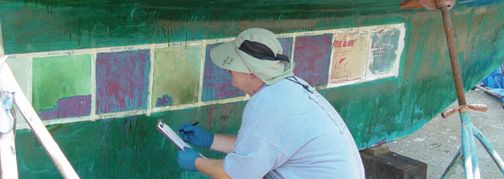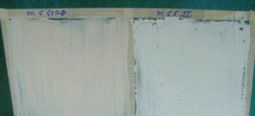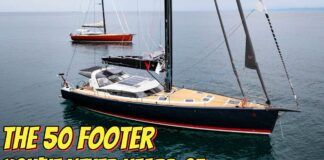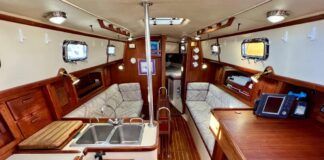To paraphrase from our 2000 paint stripper test: What expletive that we havent used before can we possibly mutter to describe the onerous task of stripping bottom paint? From application of the gelatinous goo to the scraping, wiping, and sanding, its simply one of the most-if not the most-tiring, nasty jobs a boat owner faces below the waterline.
Because removing bottom paint is such an odious task, weve tried most every method available over the years: scraping, sanding (both wet and dry), sand blasting, soda blasting, and chemical strippers. None is ideal, and each has its own set of pros and cons. The con-cern with early strippers was the toxic nature of the products. The active ingredient used in many was methylene chloride, a known carcinogen.

The good news is that chemical companies have developed and promoted safer, more environmentally friendly strippers over the last several years. These greener products have significantly gained in popularity (the bulk of strippers in our test allowed soap and water cleanup) and have been the focus of our last two stripper tests.
WHAT WE TESTED
Back To Nature had three strippers in the running: Ready-Strip, Aqua-Strip, and Ultra-Strip. Other products tested were Sea Hawk Marine Paint Stripper, Interlux Interstrip 299E, Pettit Bio-Blast, Franmars Soy Strip, Peel Away Marine Safety, and Peel Away Marine Strip II. Produced by Dumond Chemicals, Peel Away products were our top picks in our most recent update on paint strippers (Strippers 2000: Peel Away Still Champ, September 2000) as well as previous tests.
The test group included strippers with a variety of dwell times (the time it takes the product to work), ranging from 15 minutes to 24 hours. In general, the shorter the dwell time, the more powerful the stripper; however, this can be a bit misleading as many with longer recommended dwell times are supposed to be gentler on the gelcoat. Faster-acting strippers (such as Interstrip 299E and Pettit Bio-Blast) remove paint faster, but may present a greater risk of gel-coat damage if manufacturers instructions arent followed closely.
HOW WE TESTED
Our test boat was a 1978 Union 36 with three to four layers of blue, ablative bottom paint. (We mention the color here because our test boats gelcoat below the waterline is red, making the amount of paint removed relatively easy to see.) Testers applied each stripper-following each manufacturers instructions to the letter-to 1 foot x 1 foot sections of our test boats keel. Test results are based on the amount of paint removed from each test panel with a putty knife after the products maximum recommended dwell time. The percentage of paint removed given in the test results is approximate, but we believe a fair comparison of how each product performed. Also compared was ease of application, cleanup, price, and performance. The high temperature on the day of our test was 85 degrees.

READY-STRIP MARINE
One of three strippers by Back to Nature Products that PS tested, Ready-Strip Marine is billed as an environmentally friendly, biodegradable stripper that wont damage gelcoat (or any surface, according to the instructions), and can remove most types of marine paints, varnishes, urethanes, and bottom paints from fiberglass, wood, aluminum, etc.
Ready-Strip is unique among the strippers tested: It changes color (from blue to light blue or off-white) to indicate when stripping action is completed, normally four to 24 hours. An eggshell-like skin formed over the stripper after about four hours (manufacturer states this helps lock in the stripper to improve performance), after which the product was dry to the touch, but presumably still eating away at the bottom paint.
We scraped a small area after four hours (the minimum time recommended), and the panel was completely scraped at 24 hours (the maximum recommended time). Approximately 85 percent of the paint came off at the four-hour mark. However, performance was not as good after 24 hours (about 70 percent), possibly due to the products drying out overnight and some coating resolidifying.
Bottom Line: Ready-Strip did better after four hours than after 24 hours. This emphasizes the need to determine dwell time based on a test patch rather than assuming the max time is best. With 85 percent removal, Ready-Strip is a stripper wed recommend.
AQUA-STRIP

Advertised as a technically advanced, safer marine stripper designed to remove multiple layers of marine anti-fouling, topside and other paints, and varnishes in one application, Back to Natures Aqua-Strip can be used on fiberglass, wood, and aluminum. Like Ready-Strip, Aqua-Strip is pastelike; its thick enough to cling well to the vertical test panel, but still goes on smoothly.After the maximum wait time of 24 hours, Aqua-Strip peeled off easily (in sheets almost) and removed approximately 85 percent of the paint.
Bottom Line: Aqua-Strip performed well overall and a bit better than Ready-Strip, although it costs roughly $15 more per gallon.
ULTRA-STRIP
Billed as a fast stripper, Back to Natures Ultra-Strip is advertised as being able remove one layer of paint in as little as 15 minutes and two to four layers in less than four hours. Although it was a bit on the thin side, Ultra-Strip still clung fairly well to the vertical test panel.
As speed stripping is the primary claim to fame here, we scraped the test panel after 15 minutes. Ultra-Strip removed roughly 40 percent of the bottom paint the first go around. However, after a second application and recommended maximum four-hour wait (for three to four layers of paint), we removed close to 85 percent of the paint on the test panel.
Bottom Line: Although Ultra-Strip removed 85 percent of the bottom paint on the test panel, it took two applications and four hours, which really wasnt any faster than the other quick-acting strippers-like Inter-strip and Bio-Blast, both of which are also a bit cheaper.
As a side note: We also tested Ultra-Strip on the Unions transom where the boat name and homeport were painted on roughly 15 years ago and had been re-painted a few times. We could see the paint lifting within a few minutes. After 15 minutes, we easily scraped off the remainder with a plastic putty knife. Once the area was cleaned with a soft scrub pad and mild powder cleaner, no paint remained.
SEA HAWK MARINE PAINT STRIPPER
Sea Hawk markets Marine Paint Stripper as a safer marine paint remover that works on antifouling, topside paints, and varnishes and is safe for use on gelcoat, fiberglass, and aluminum and other metals. The recommended dwell/test times for the Sea Hawk Marine Paint Stripper were 30 minutes, six hours, and 24 hours. Sixty percent of the bottom paint in a small scraping of our test panel was removed at 30 minutes, with 70 percent removal at both the six- and 24-hour marks. The product was still moist at the six-hour point, but was dry at 24 hours.
Bottom Line: Although the test panel wasnt difficult to scrape at 24 hours, it was easier to remove the bottom paint at six hours. In our test, the additional wait time didnt improve the stripping action.
INTERLUx INTERSTRIP
Interlux Interstrip 299E is a semi-paste paint remover that incorporates special sealing agents that allow the stripper to stay wet longer, increasing its action time.
Although more environmentally friendly from the standpoint that it contains no methylene chloride, Interstrip 299E is nonetheless some pretty strong- and noxious-smelling stuff. Its also rated as flammable and as being capable of producing explosive vapors when exposed to heat (according to its Material Safety Data Sheet), and while advertised as safe for fiberglass, instructions caution not to leave it on more than eight hours as gelcoat damage may occur.
As claimed, Interstrip was moist and appeared to be still going strong at the maximum two-hour mark. However, this increased action could be both blessing and curse (due to possible gelcoat damage), if youre not careful to thoroughly remove all residue from the area being stripped once completed. (As is the case with many of these strippers.)
Interstrip powered off 60 percent of the bottom paint on our test panel in 30 minutes and 70 percent at the two-hour maximum recommended time. Some gelcoat damage occurred in our test panel by the two-hour mark however, proving the importance of conducting a dwell-time test.
Bottom Line: Interstrip 299E worked well and was one of the least expensive test products, but, in our opinion, its potent chemical nature makes it less desirable than the others. Given our experience, this product requires care, particularly on older hulls with tired and likely more porous gelcoats.









































Mr Nicholson,
I’m a boat surveyor and Practical Sailor is my reference when I want to share with my customers. Before to do it, I try suggestion on my personal sailboat and give the reference. So, I tried to refer Bottom Paint Stripper but I forgot to read you before so, I tried Captain PHAB Marine Strip-it on my sailboat and I was really disappointed with. After 5 or 6 layers of the product, nothing was stripped.
Tonight, I read you and saw that the best is Peel Away but now, I can found it. Instead, I found SmartStrip from the same ice (Dumond) so, is it equivalent?
I should appreciate your recommandation for the Bottom Paint Stripper.
Excuse my bad english langage, I’m a french canadian guy.
Thank you in advance!
Jacques
Mr Nicholson,
I’m a boat surveyor and Practical Sailor is my reference when I want to share with my customers. Before to do it, I try suggestion on my personal sailboat and give the reference. So, I tried to refer Bottom Paint Stripper but I forgot to read you before so, I tried Captain PHAB Marine Strip-it on my sailboat and I was really disappointed with. After 5 or 6 layers of the product, nothing was stripped.
Tonight, I read you and saw that the best is Peel Away but now, I can’t found it. Instead, I found SmartStrip from the same cie (Dumond) so, is it equivalent?
I should appreciate your recommandation for the Bottom Paint Stripper.
Excuse my bad english langage, I’m a french canadian guy.
Thank you in advance!
Jacques
(This is my second comment, I correct some mistake)
good bus
hurries